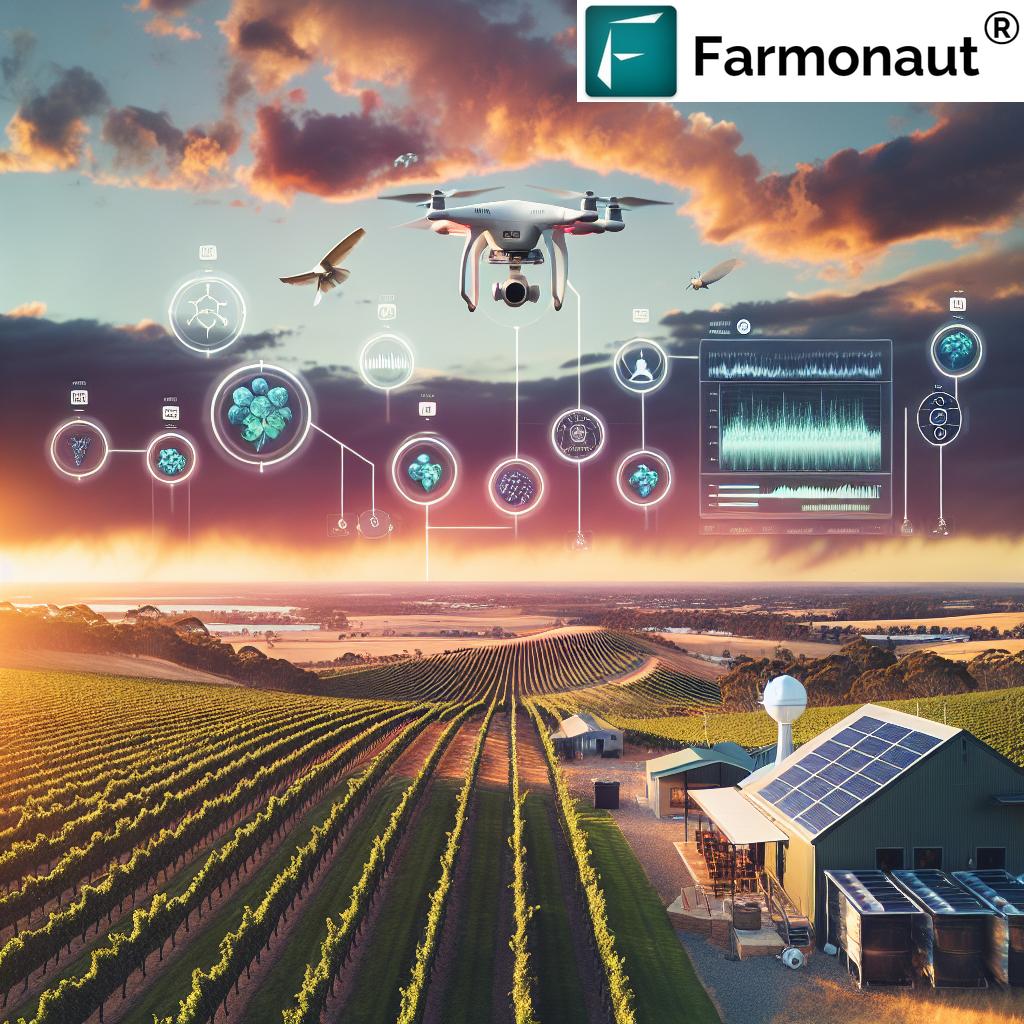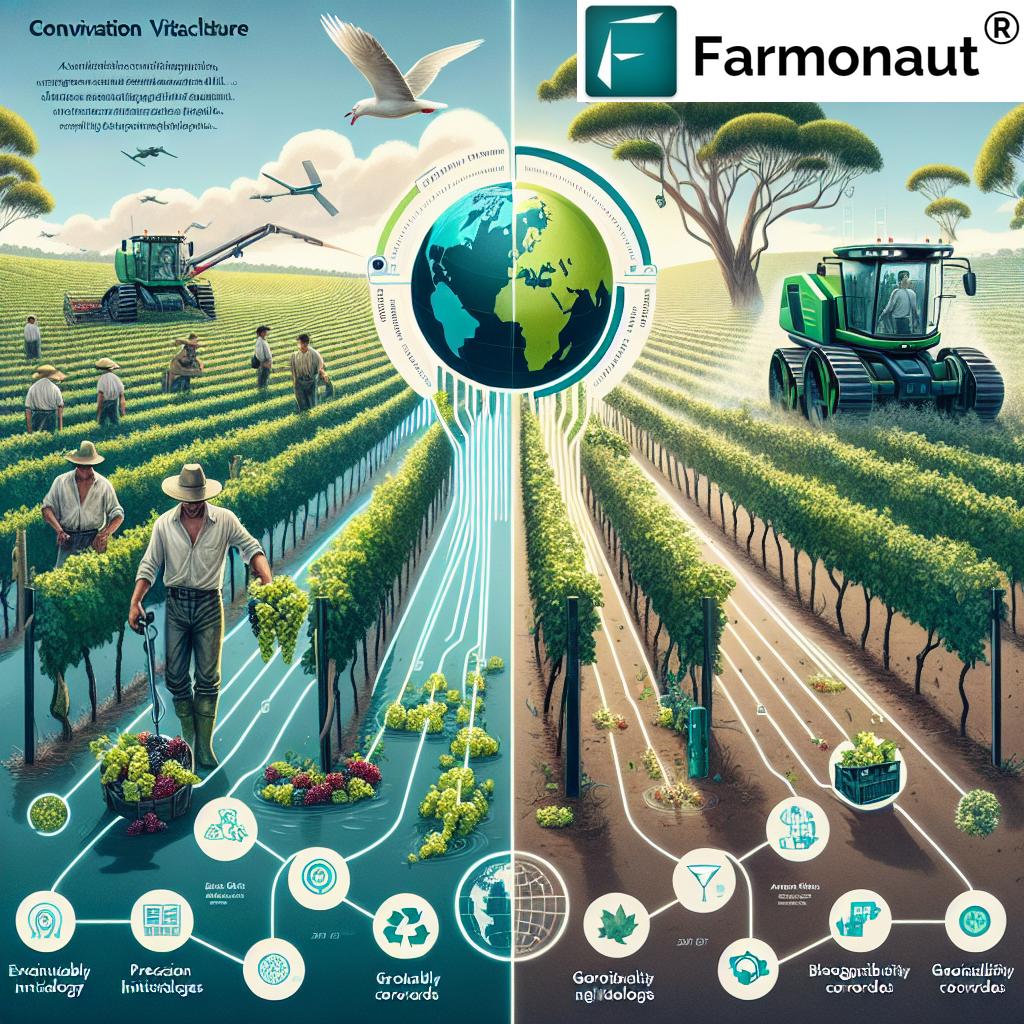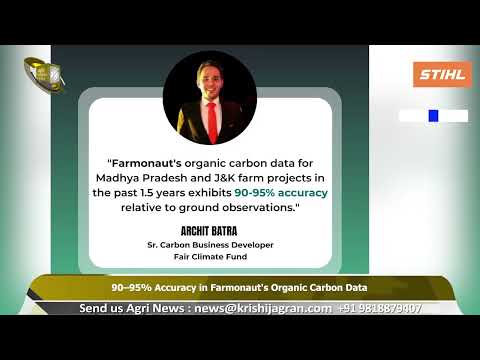Revolutionizing Australian Vineyards: GIS-Powered Sustainable Winegrowing for Global Export Success
“Australian vineyards using GIS technology have reduced carbon emissions by up to 30% in sustainable winegrowing practices.”
Welcome to the forefront of Australian viticulture, where innovation meets tradition in a glass of world-class wine. In this comprehensive exploration, we’ll uncork the secrets behind Australia’s thriving wine industry and its journey towards sustainable winegrowing practices. From the sun-drenched vineyards of South Australia to the cool-climate regions of Tasmania, we’re witnessing a revolution in how we grow, produce, and export our beloved wines.
As we delve into the intricacies of GIS-powered vineyard management and the latest trends in wine export markets, we’ll discover how Australian winemakers are not just adapting to change but leading the charge in sustainable viticulture. So, pour yourself a glass of your favorite Australian wine, and let’s embark on this exciting journey through the future of winemaking Down Under.
The Australian Wine Industry: A Toast to Innovation
The Australian wine sector has long been known for its bold flavors and innovative spirit. Today, we’re witnessing a transformation that goes beyond the bottle, encompassing every aspect of wine production from vine to wine. Let’s explore the key elements driving this revolution:
- Sustainable winegrowing practices
- GIS technology in vineyard management
- Carbon emissions reduction in viticulture
- Organic wine production
- Climate impact on winegrowing strategies
At the heart of this transformation is the integration of Geographic Information Systems (GIS) into vineyard management. This technology is revolutionizing how we understand and interact with our terroir, enabling precision viticulture on a scale never before possible.

GIS: The New Backbone of Vineyard Management
GIS technology is transforming the way we manage our vineyards, offering unprecedented insights into every aspect of wine production. Here’s how GIS is making a difference:
- Precise mapping of soil types and microclimates
- Real-time monitoring of vine health and growth patterns
- Optimized irrigation and resource allocation
- Early detection of pest and disease outbreaks
- Tailored harvesting schedules for optimal grape quality
By harnessing the power of satellite imagery and data analytics, Australian winemakers are taking vineyard management to new heights. This level of precision not only improves wine quality but also contributes significantly to sustainable practices and carbon emissions reduction.
Sustainable Winegrowing: A Green Revolution in Viticulture
Sustainability is no longer just a buzzword in the Australian wine industry; it’s a fundamental principle guiding our practices. From the vineyard to the winery, we’re implementing innovative solutions to reduce our environmental footprint:
- Water conservation through precision irrigation
- Integrated pest management to reduce chemical use
- Renewable energy adoption in winery operations
- Biodiversity promotion in and around vineyards
- Carbon sequestration through improved soil management
These sustainable winegrowing practices not only benefit the environment but also enhance the quality and uniqueness of our wines, giving Australian producers a competitive edge in global markets.
“Organic wine production in Australia has grown by 120% over the past decade, driven by global demand.”
The Rise of Organic Wine Production
The demand for organic wines is soaring, and Australian winemakers are at the forefront of this trend. Organic wine production in Australia has seen remarkable growth, driven by several factors:
- Increasing consumer awareness of health and environmental issues
- Improved quality and consistency of organic wines
- Government support for organic farming practices
- Enhanced soil health and biodiversity in organic vineyards
- Premium pricing opportunities in export markets
As we continue to perfect our organic winemaking techniques, we’re not just meeting global demand – we’re setting new standards for quality and sustainability in the industry.

Climate Impact and Adaptive Strategies in Australian Viticulture
Climate change is presenting both challenges and opportunities for Australian winemakers. We’re adapting our practices to ensure the continued success of our industry:
- Exploring new grape varieties suited to changing climates
- Implementing canopy management techniques to protect grapes from extreme heat
- Adjusting harvest times to maintain optimal grape ripeness
- Investing in research on drought-resistant rootstocks
- Developing climate-resilient vineyard designs
By staying ahead of climate trends, we’re not just preserving our winemaking heritage – we’re innovating for a sustainable future.
Navigating Wine Export Markets: From Australia to the World
Australian wines continue to make waves in international markets. Here’s how we’re positioning ourselves for global export success:
- Tailoring wine styles to meet diverse consumer preferences
- Leveraging geographical indications to highlight regional uniqueness
- Embracing e-commerce and direct-to-consumer channels
- Developing sustainable packaging solutions for export
- Building strong brand narratives around sustainability and innovation
Our focus on quality, sustainability, and innovation is opening doors in established markets like Europe and North America, while also creating exciting opportunities in emerging markets across Asia.
Explore our API for advanced agricultural insights.
The Role of AgTech in Modern Vineyard Management
AgTech solutions are revolutionizing vineyard operations, offering unprecedented control and efficiency:
- Drone technology for aerial vineyard surveillance
- IoT sensors for real-time monitoring of soil and vine conditions
- AI-powered predictive analytics for yield forecasting
- Robotics for precision pruning and harvesting
- Blockchain for enhanced traceability and authenticity verification
These technological advancements are not just improving efficiency; they’re enabling us to produce higher quality wines while reducing our environmental impact.
Check out our API Developer Docs for integration details.
Pest and Disease Management: A Sustainable Approach
Effective pest and disease management is crucial for sustainable viticulture. We’re adopting innovative strategies to protect our vines:
- Biocontrol agents to manage pest populations naturally
- UV-C light technology for mildew control
- Pheromone disruption techniques for pest mating cycles
- Machine learning algorithms for early disease detection
- Cover cropping to promote beneficial insect populations
These methods not only reduce our reliance on chemical interventions but also contribute to the overall health of our vineyard ecosystems.
Geographical Indications: Celebrating Regional Diversity
Australia’s diverse wine regions are one of our greatest strengths. We’re leveraging geographical indications (GIs) to showcase this diversity:
- Promoting unique terroir characteristics of each region
- Developing wine tourism routes based on GIs
- Collaborating on regional marketing initiatives
- Implementing strict quality standards for GI-labeled wines
- Educating consumers about the significance of Australian GIs
By emphasizing our regional diversity, we’re not just selling wine – we’re inviting the world to experience the rich tapestry of Australian winemaking.
Download our app for on-the-go vineyard management:
The Future of Australian Viticulture: A Sustainable Vision
As we look to the future, the Australian wine industry is committed to a path of continuous innovation and sustainability:
- Investing in research for climate-resilient grape varieties
- Developing carbon-neutral winemaking processes
- Expanding regenerative viticulture practices
- Enhancing traceability from vineyard to consumer
- Fostering collaboration between technology providers and winemakers
Our goal is not just to adapt to change but to lead the global wine industry towards a more sustainable and innovative future.
Comparative Analysis: Traditional vs. GIS-Powered Vineyard Management
To truly appreciate the revolutionary impact of GIS technology on Australian viticulture, let’s compare traditional methods with the Farmonaut satellite system approach:
| Vineyard Management Aspect | Traditional Method | Farmonaut Satellite System |
|---|---|---|
| Irrigation Efficiency | Manual scheduling based on visual inspection | Precise water management using real-time vegetation indices and soil moisture data |
| Pest Detection | Regular physical inspections | Early detection through multispectral imagery analysis |
| Soil Health Monitoring | Periodic soil sampling and lab analysis | Continuous monitoring via satellite-derived soil health indicators |
| Climate Impact Assessment | Reliance on regional weather forecasts | Microclimate analysis using high-resolution satellite data |
| Sustainable Practices Implementation | Generalized approach based on industry standards | Tailored sustainability strategies informed by AI-driven insights |
This comparison clearly demonstrates the transformative potential of GIS technology in modern vineyard management, highlighting how Farmonaut’s innovative solutions are driving efficiency, sustainability, and quality in Australian viticulture.
Embracing Technology for Sustainable Winegrowing
As we’ve explored throughout this article, the integration of GIS technology and sustainable practices is reshaping the Australian wine industry. From precision vineyard management to innovative export strategies, we’re witnessing a revolution that promises to enhance both the quality of our wines and the health of our environment.
By embracing these technological advancements and sustainable approaches, Australian winemakers are not just adapting to change – they’re leading the way towards a more resilient and innovative future for global viticulture. As we raise a glass to the future of Australian wine, we toast to a industry that’s as sustainable as it is successful.
Ready to revolutionize your vineyard management? Try Farmonaut today:
FAQs
- How is GIS technology improving wine quality?
GIS technology enables precise monitoring of vine health, soil conditions, and microclimates, allowing for targeted interventions that enhance grape quality and, consequently, wine quality. - What are the main benefits of sustainable winegrowing practices?
Sustainable practices reduce environmental impact, improve soil health, enhance wine quality, and often lead to cost savings through efficient resource use. - How is climate change affecting Australian vineyards?
Climate change is altering growing seasons, necessitating adaptations in grape varieties, vineyard management techniques, and even the geographical distribution of vineyards across Australia. - What role does organic wine production play in the Australian wine industry?
Organic wine production is growing rapidly, meeting increased consumer demand for environmentally friendly and health-conscious products while often commanding premium prices in export markets. - How are Australian wines performing in global export markets?
Australian wines continue to perform strongly in traditional markets like the UK and US, while also gaining traction in emerging markets across Asia, particularly with premium and sustainable wine offerings.






